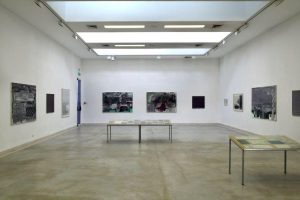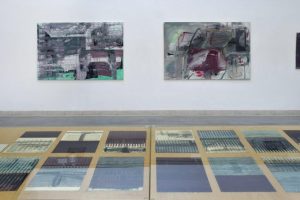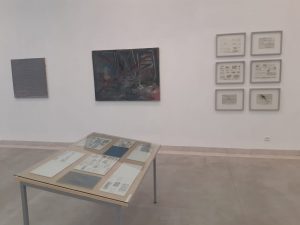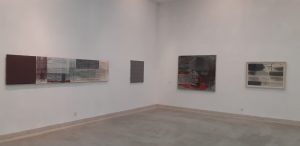Moshe Kupferman – The Plural Form – November 2018
The title “The Plural Form” brings a grammatical term to the visual field, placing multiplicity at the center of Moshe Kupferman’s formal language, which is presented in this exhibition through works spanning over three decades, from the mid-1960’s to 1999
Singular/Plural
The “plural form” of these works is expressed through the many visual possibilities that they contain, without granting preference to any one of them. Concurrently, within and among the works a great similarity in structure, shapes and colors is apparent, leading painter Larry Abramson to write that Kupferman “went…to the studio to paint his one and only painting anew, every day.”Two groups of drawings exhibited in the display tables shed light on the relationship between singular and plural, between that imaginary one and only painting and its many components. First, sketchbooks from the 1960’s reveal a unique expression of multiplicity and repetition, with ink drawings of numerous rectangular frames filled with abstract imagery, organized in various ways across the page. Each framed images is both an autonomous element and a part of a larger composition. Second, the “Group of Sixteen Units,” created in the 1990’s, consists of sixteen drawings that originate from one large sheet of paper. Their grouping together, encased in a cardboard folder, creates a two-way discourse between part and whole.
A grid scheme appears repeatedly in the paintings and works on paper in the show, while acting as an unseen organizing structure for the components of many of them – from the ink sketches, through newspaper page imagery that appears in a number of works on paper, and up to paintings from the nineties. A closer look at the grid reveals that its own internal structure is one of multiple recurring units, each one a delineated element as well as a fragment of a continuous pattern. More than one signature appears in some works, a surprising form of multiplicity that raises questions about the finality of their completion. Finally, even the works’ coloration fuses singular and plural: a purple-grey hue dominates most of them, and according to the artist it was first created by blending all of the paint colors after they were scraped off the canvas.
You are invited to view the entire exhibition as a dialogue between components and systems: there are works composed of various units placed next to one another – such as the ink sketches and the large works on paper – and others with layered, partially overlapping yet distinct areas – such as Scroll from 1999 (left of entrance) and the painting from 1997 (exhibited on the opposite wall). Notice the lack of a single center or focal point in Kupferman’s works, which instead contain many such points, with no hierarchy among them. This do not lead to compositional breakdown or disintegration, but rather creates a kind of visual conversation, resulting in layered and multifaceted compositions. Interspersed among these compositions are five square paintings from 1981-1983 with relatively simple structures, which may be viewed as building blocks for the complex works adjacent to them – yet despite their spare appearance, even they reveal multiple and repeating components, mostly horizontal or vertical strokes of the paintbrush or roller.
Multiple Interpretations
The features of multiplicity and repetition in the works of Moshe Kupferman have spawned diverse readings. Two examples are their interpretation as evidence of obsessive processing of traumas that the artist endured during World War II,[3] or as expressions of the pluralistic heritage of Jewish study and Talmudic discourse.[4] In addition, the multifocal and centerless aspects of Kupferman’s abstraction have been juxtaposed to the qualities of reduction and purity often attributed to modern abstract painting, based on a view of the latter as advancing gradually toward its essence and completion. These ideas led curator Ulrich Loock to detect traces of a twofold act of mourning in Kupferman’s work, in reaction to both the end of painting and the destruction of European Jewry.[5] Looking at the works in this exhibition, they may be viewed as offering a powerful alternative to approaches based on a linear, one-way progression leading inevitably to an end-point – whether in relation to art history or to human history. This alternative is abundant and expansive, combining chaotic elements with containing structures, and creating endless combinations between similar parts. And instead of mourning, or perhaps alongside it, Moshe Kupferman’s manifold visual language exudes playfulness and freedom, which enabled creation of the singular and multiple work, repeated and transformed every day, anew.
Ruth Kestenbaum Ben-Dov, November 2018




